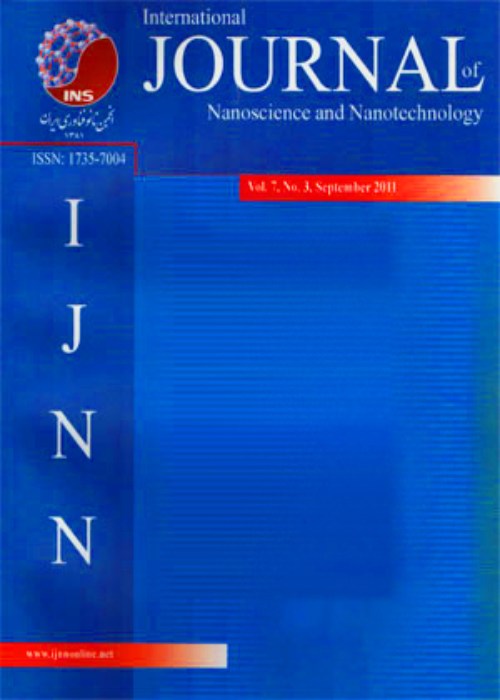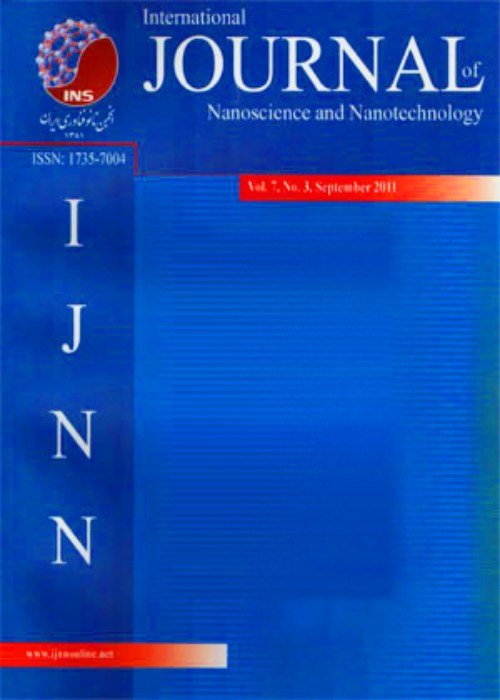فهرست مطالب

International Journal Of Nanoscience and Nanotechnology
Volume:19 Issue: 3, Summer 2023
- تاریخ انتشار: 1402/06/09
- تعداد عناوین: 6
-
-
Pages 135-147This work sought to compare the photocatalytic efficiency of nickel (II) oxide nanoparticles (NiO-NPs) for the degradation of methylene blue (MB) and Rhodamine B dye (Rh B). NiO-NPs were synthesized by a green, simple and easy route using the plant extract H. Hirsuta. The morphological characteristics of the synthesized NiO NPs were characterized by SEM. In addition, UV-vis, XRD, FTIR and EDS analyses were also performed to investigate the optical properties, crystal size, functional groups and elemental composition of the NPs. These NiO NPs have a crystallinity size of 20.82 nm, and then were used for photocatalytic degradation of MB and Rh B in the presence of visible light irradiation. The photocatalytic degradation rate under optimal conditions of MB and Rh B was found to be 97.19% and 79.42% , respectively. The kinetic study of photocatalytic degradation followed pseudo-first-order kinetics for MB and Rh B dyes. In addition, NiO-NPs were used for a 4-nitrophenol reduction activity reaching 91.17% for 3 cycles.Keywords: Nickel oxide nanoparticles NiO-NPs, H. Hirsuta plant extract, 4-Nitrophenol, Dye degradation, Methylene blue, Rhodamine B.
-
Pages 149-164In this review we present some design of CNTFET-based circuits, already proposed by us and here critically examined. For some of these, we compare the performance of proposed circuits both in CNTFET and CMOS technology. For CNTFET model, we use a compact, semi-empirical model, already proposed by us and briefly recalled, while, for the MOSFET model, we use the BSIM4 one of ADS library. Moreover in some design examples we compare our results with those obtained using the Stanford model. All simulations are carried out using the software ADS, which is compatible with the Verilog-A programming language.Keywords: CNTFET, CMOS, Modelling, Design of A, D circuits, Advanced Design System.
-
Pages 165-172An appropriate analytical method has been used to solve the Schrödinger equation, for a polynomial anharmonic potential to obtain the eigen-energy levels, up to the second order. Moreover, the derived expression has been exploited in the case of the Morse potential that led to express the vibrational energy of diatomic molecules. The application of the proposed analytical method to some selected molecules makes it possible to obtain results that are in good agreement with those available in the literature, and proves that our approach can be a valuable aid in spectroscopic experiments.Keywords: Anharmonic, Morse potential, Diatomic Molecule, Energy levels.
-
Pages 173-186Achieving low power consumption and low delay are the most important goals that efforts have been made to reach. In this paper, the process of designing and optimizing the Phase Frequency Detector (PFD) performance at the integrated circuits (IC) level has been proposed using carbon nanotubes. In the proposed method, by using carbon nanotube transistors, improvements have been made in the output parameters of the phase detector. Failure to use flip-flops and the simple circuit structure will significantly increase speed and reduce power consumption. Post-layout simulation for 180nm CMOS technology and simulation results for 32nm Carbon Nanotube Field-Effect Transistor (CNTFET) technology is presented. The proposed CMOS 28T phase detector circuit, by injecting 30mV peak-to-peak power supply noise has 5× better operating frequency of the conventional circuit, and it has a 10% improvement in power consumption of the conventional one. Also, with carbon nanotubes, the frequency has increased 4 times, and the power consumption has improved significantly. In this case, the power consumption is 1.76 microwatts, and the operating frequency is 20 GHz. Open-loop design and elimination of the reset path, and attention to delays to remove the dead zone are the proposed circuit's top features compared with the traditional design methods.Keywords: phase-frequency detector, Zero dead-zone, low power consumption, HIGH FREQUENCY, Carbon nanotubes.
-
Pages 187-198The present study aims to evaluate the effect of silver nanoparticles (AgNPs) on the enzymatic activity of fungal amylase and cellulase. The AgNPs were synthesized using aqueous fresh leaf extract of Camellia sinensis of AgNPs. The synthesis of nanoparticles was initially observed by a visible colour change and further confirmed by UV-Vis spectrum analysis. Fourier transform infrared spectroscopy (FTIR) identified the functional groups and their relevant biomolecules such as amide, alkene, carbonyl, and hydroxyl groups present in the aqueous leaf extract of C. sinensis. These biomolecules were responsible for the synthesis, capping, and stabilization of the AgNPs. The field emission scanning electron microscope (FESEM) image showed spherical and polydispersed AgNPs with a diameter of 22-55 ±2 nm. The energy dispersive X-ray (EDX) analysis illustrates 91.19% silver in the synthesized AgNPs. The effect of synthesized AgNPs on the enzymatic activity of fungal amylase and cellulase was evaluated using the 3,5-dinitrosalicylic acid (DNSA) method. The enzymatic activity of fungal amylase and cellulase increased significantly with increased concentration of AgNPs. The enhancement in the amylase and cellulase activity achieved through nanoparticles may be further explored for its industrial applications.Keywords: Green synthesis, Camellia sinensis, Silver nanoparticles, nanocatalyst First, Second, Third.
-
Pages 199-207
The formation of zinc sulfide (ZnS) is the most promising semiconductor material, particularly for optical and photovoltaic applications. The influence of the number of cycles on ZnS thin films deposited at room temperature was studied. According to our findings, the results showed that the number of deposition cycles affected the crystallinity, grain size, film thickness, and shape of the obtained films. The XRD analysis confirmed that the thin films fabricated had a crystalline structure of zinc blend ZnS with a preferred orientation in the plan (111). The gap energy of ZnS has been obtained in the range of 3.34 eV to 3.68 eV.
Keywords: SILAR, Zns, XRD, Band gap energy, Sulfurization, SEM.


